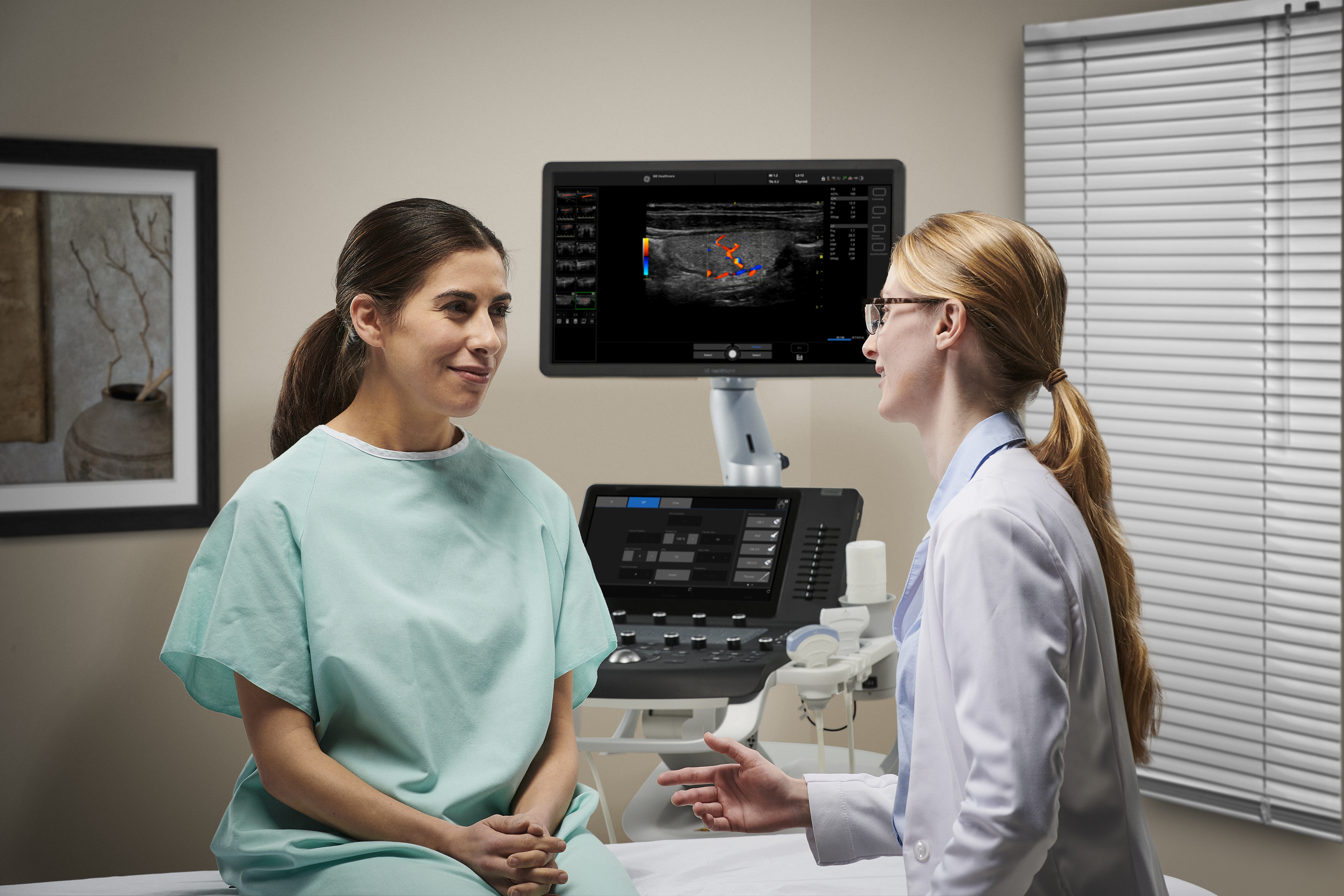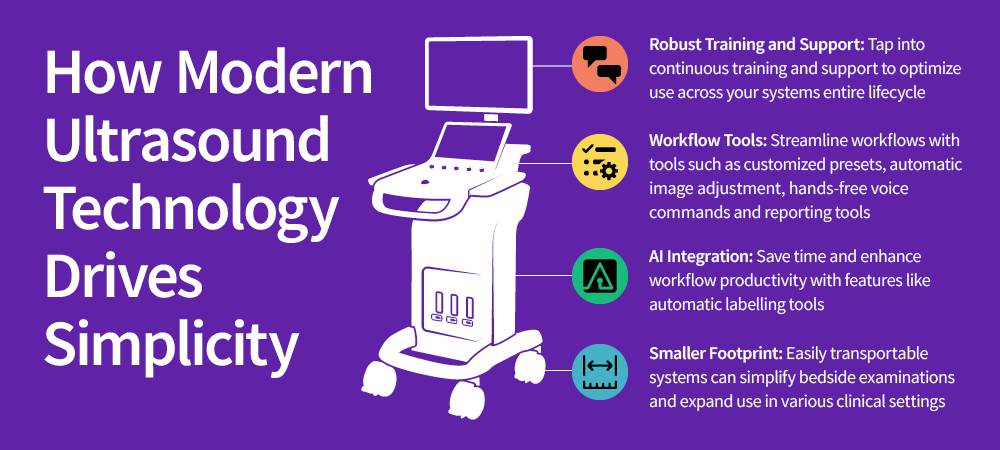In today's healthcare ecosystem, general practitioners (GPs) have significantly increased opportunity (and, in fact, expectation) to grow the scope of their practice on a consistent basis. When it comes to expanding their care services, treating more conditions, and caring for more patients who need them, technological advancements have made the possibilities virtually endless.1
One factor that has made this level of expansion possible is the continued integration of primary care ultrasound. Expanding diagnostic services is one of the most effective ways for primary care physicians to increase their scope of care, and a versatile ultrasound system can make it easier than many GPs realize. Advancements in technology and functionality allow primary care ultrasound to adapt to even the most remote and "bare bones" environments, from outpatient clinics to field hospitals.
Investment in the right system can not only strengthen and enrich the quality of care under your roof; it can also significantly increase revenue and allow you to turn your practice into a diagnostic center of excellence. This article examines how primary care ultrasound enables private practices of all sizes to branch out to new areas of specialization and the areas experiencing the most growth. We also explore how general practitioners can leverage this technology in their practices.
From referral to readiness: Where can primary care ultrasound take your practice?
Private practices are often formed and cultivated due to the circumstances and demographics of the communities in which they're established. For example, your community may include:
- A population that's particularly vulnerable to heart disease
- A large population of residents who are younger and getting ready to start families
- People who commonly experience work-related pain and injury
No matter your unique circumstance, your practice should be agile and intuitive enough to help meet these needs.
The good news is that the right primary care ultrasound system can help you get there more easily than ever before. It can transform your practice from a place where patients go to for referral for specialized care to a place where they potentially get that care without the need for additional appointments.
Let's examine some of the most relevant specialty areas currently being folded into primary care practices' ultrasound services and capabilities.
Abdominal imaging
Abdominal imaging has been found to be one of the fastest-growing areas of primary care ultrasound integration, accounting for an overwhelming majority of scans performed by GPs in one recent international study.2 Enhanced image quality and next-level ease of use have allowed GP's to use ultrasound for early and proactive detection of a range of abdominal conditions, such as:
- Cholecystitis
- Cholelithiasis
- Hydronephrosis
- Abdominal aortic aneurysm
- Ascites
OB/GYN medicine
It's never been easier for GPs to absorb the work of routine OB/GYN exams into their scope of care. Newer and more user-friendly systems enable GPs to perform these routine tasks, among others:3
- Assess fetal health and positioning
- Estimate gestational age
- Measure fetal heartbeat
- Locate an intrauterine device (IUD)
- Identify ovarian cysts and uterine fibroids
Clinicians can use these diagnostic and monitoring tools in all stages of pregnancy and gynecological cycles, potentially reducing the need for fragmented care during exam processes. An established and growing body of data supports the assertion that clinicians should consider ultrasound a routine extension of practice.4
Cardiac care
One of the earliest converts to the primary care paradigm, cardiac ultrasound, can be used by general practitioners to detect heart abnormalities more quickly, form a more cohesive care plan, expedite treatment, and improve overall outcomes. This is particularly true for older patients who are prone to heart disease beyond the age of 50.5
The use of cardiac ultrasound for GPs has already proven to be useful, detecting a wide array of heart conditions, such as left ventricular hypertrophy (LVH), in patients with hypertension.6 But primary care physicians can also empower themselves to detect plaque in carotid arteries and other types of preventable heart disease.7
Musculoskeletal care
Whether the result of acute or chronic conditions, the need for and application of musculoskeletal (MSK) ultrasound has increased dramatically in recent years, and it's finding its natural fit in the doctor's office. There needs to be a shift in focus, whereby some of the common ultrasound-guided procedures are performed by GPs in a primary care environment, providing patients with optimal, local care, while reducing healthcare costs and the burden on secondary care.8
Primary care physicians have been able to utilize ultrasound in a variety of MSK applications, including but not limited to guided soft-tissue injections for large joints, inflamed joints, subacromial bursitis, and carpal tunnel syndrome.9
MSK primary care ultrasound can also help GPs detect and manage acute, injury-related conditions, such as long-bone fractures, muscle and tendon injuries, and vascular occlusions, as well as tenosynovitis.
Top-tier care that increases your practice's bottom line
In addition to allowing you to provide better care and expand your clinical footprint, growing your scope of practice has obvious revenue benefits. Bringing certain types of ultrasound into your practice allows for increased insurance reimbursements under more diagnostic codes, less reliance on referrals, and the ability to attract new populations of patients.
Whether you're looking to open a satellite facility where your patients can go to get scanned or bring everything in-house, primary care ultrasound allows you to offer your current patients a greater and more comprehensive degree of care. At the same time, you can use this technology to quickly adapt to the aforementioned shifting demographics and health-determinant factors within your community.
From a less direct (but no less impactful) administrative standpoint, in-house primary care ultrasound frees your front-of-office staff from coordinating offsite ultrasound referrals and follow-ups with specialists. This is particularly important for practices in lower-resourced areas with limited personnel who need to focus solely on patient care and comfort.
Many benefits, few barriers: Integrating ultrasound to expand your practice's capabilities
Historically, ultrasound has been considered the purview and domain of specialists, making many GPs and other non-radiological care providers reluctant to fold it into their scope of care. Today, however, overcoming the perceived educational, financial, and logistical barriers associated with ultrasound integration is much simpler. Here are just a few game-changing elements that can help even the smallest and newest practices start their journey toward becoming ultrasound centers of excellence in their communities.
Ergonomics and mobility
As space continues to be at a premium for clinics and practices worldwide, today's most versatile primary care ultrasound systems offer lightweight portability and ease of movement, so they never occupy permanent square footage in your facility. Institutions can now bring even premium-tier machines to patients' bedsides, while compact units can travel with your staff.
Forward-thinking and scalable capabilities
Imagine a primary care ultrasound system that's essentially as simple as "plug and go." The most versatile systems offer specific presets, probes and software to help you quickly upgrade your existing system and guide your practice to adapt to the changing needs of your patient population. These features allow you to break into whole new areas of specialization with minimal disruption and investment.
Smart and intuitive features
Automated image guidance, hands-free voice commands, needle recognition, state-of-the-art color and image refinement, and many other features have eliminated the need for guesswork and unnecessary manual effort while performing scans. Many of today's systems are built for new users with smaller clinics and limited budgets. You can perform scans with confidence and assurance with teams of any size.
Next-level training and support
To offer even more assurance and confidence, the most versatile primary care ultrasound systems provide personalized training, support, and education baked right into the purchasing agreement. The right vendor will ensure seamless and proper set-up of your system, offer personalized guided training for your team, and provide expert support if you need repair or operability assistance. They can also help guide you in the upgrade process if you need more features and capabilities.
Finally, and perhaps most importantly to many GPs, system options help clinics of all different budgets adopt primary care ultrasound into their scope of care. This means that your practice can leverage ultrasound in its continued expansion with less investment than you may think.
If you want your practice to grow quickly and substantially by offering more comprehensive care, there's no better place to start than with the diagnostic process, and primary care ultrasound is leading the way forward.
Reliable, affordable, easy-to-use and versatile, Versana ultrasound systems have a variety of automation features, intuitive controls, and budget-friendly options to best meet patient needs.
REFERENCES:
1. From overwhelmed to optimised: How technology helps GPs enhance their practice. GPonline, March 6, 2023. https://www.gponline.com/overwhelmed-optimised-technology-helps-gps-enhance-practice/article/1812153.
2. Touhami D, Merlo C, Hohmann J, and Essig S. The use of ultrasound in primary care: longitudinal billing and cross-sectional survey study in Switzerland. BMC Family Practice. 2020;21(1). https://doi.org/10.1186/s12875-020-01209-7.
3. How ultrasound simplifies routine OB/GYN exams for physicians. (n.d.). Empowered Women's Health. https://www.volusonclub.net/empowered-womens-health/how-ultrasound-simplifies-routine-ob-gyn-exams-for-physicians/
4. Recker F, Weber E, Strizek B, et al. Point-of-care ultrasound in obstetrics and gynecology. Archives of Gynecology and Obstetrics. 2021;303(4):871–876. https://doi.org/10.1007/s00404-021-05972-5.
5. Yates JA, Royse C, Royse C, Royse A, et al. Focused cardiac ultrasound is feasible in the general practice setting and alters diagnosis and management of cardiac disease. Echo Research & Practice. 2016;3(3):63–69. https://doi.org/10.1530/erp-16-0026.
6. Bornemann P, Johnson J, Tiglao S, et al. Assessment of Primary Care Physicians' Use of a Pocket Ultrasound DeviceTM to Measure Left Ventricular Mass in Patients with Hypertension. Journal of the American Board of Family Medicine. 2015;28(6):706–712. https://doi.org/10.3122/jabfm.2015.06.140314.
7. Fedak A, Chrzan R, Chukwu O, et al. Ultrasound methods of imaging atherosclerotic plaque in carotid arteries: examinations using contrast agents. Journal of Ultrasonography. 2020;20(82):191–200. https://doi.org/10.15557/jou.2020.0032.
8.Bee WW, Thing J. Ultrasound-guided injections in primary care: evidence, costs, and suggestions for change. Br J Gen Pract. 2017 Aug;67(661):378-379. doi: 10.3399/bjgp17X692117. PMID: 28751352; PMCID: PMC5519122.
9. Bee WW, and Thing J. Ultrasound-guided injections in primary care: evidence, costs, and suggestions for change. British Journal of General Practice. 2017;67(661):378–379. https://doi.org/10.3399/bjgp17x692117.


